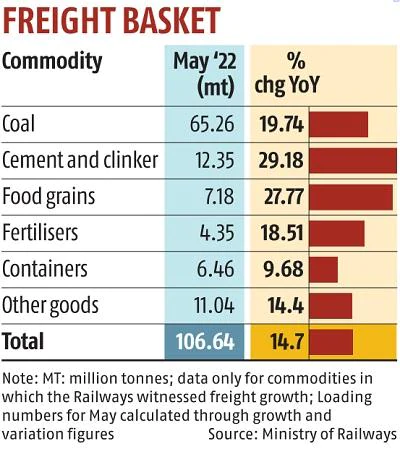Source: https://www.business-standard.com/article/economy-policy/fuelled-by-coal-demand-railways-earns-rs-14-000-crore-from-freight-in-may-122060200036_1.html
Publisher: Business Standards
Fuelled by the demand for coal and cement, the railways ferried 131.7 million tonnes (mt) of raw materials and goods in May, earning a revenue of Rs 14,113 crore. The revenue earned is 22 per cent higher than the corresponding period last year.
This is the 21st consecutive month of the national transporter topping its own freight loading record. In 2021-22, it earned over Rs 1.43 trillion from freight operations. “The incremental loading in the month of May has been 16.89 mt, a growth of 14.7 per cent over the previous best May figures achieved in 2021,” the ministry of railways said.
The cumulative loading for this year stands at 253.9 mt, an increase of 12 per cent from last year.
Major items in the railways’ freight basket showed double-digit growth — coal loading stood at over 65 mt, rising by a fifth of last year’s figures.
Amid the power crisis, the railways had also cancelled passenger trains during the month in a bid to decongest tracks. This was for priority movement of coal rakes to thermal power plants.
According to the railways, the loading of coal to power houses (both domestic and imported) increased by more than 11 mt in May with 52.4 mt coal being transported against 41.01 mt last year. This is a growth of 28 per cent.
“In terms of the number of rakes of coal loaded per day for power houses, the railways moved more than 421 rakes of domestic coal and more than 22 rakes of imported coal on a daily basis,” the ministry said.

It had previously reported that loading delays at coal sidings had been causing the daily rake transportation to go down despite adequate supply from railways.
Similarly, cement, food grains, and fertilisers also saw increased supply by the railways (see chart).
However, the ministry said that freight volume in raw materials for steel plants (including iron ore) did not see growth this year. The monthly volume was not made available in the data released by the ministry.
Last May, the railways had transported 15.12 mt of iron ore, which is the second-biggest commodity in its freight basket (approximately 12 per cent).
Freight trains ran at an average speed of 18.86 kilometres per hour (km/h), which is 15 per cent faster than last year. The average speed includes stabling and yarding time for the rakes.
Average wagon turnaround (WTR) time this month also decreased by 9 per cent to 4.37 days.
Under its Project Hungry for cargo, the national transporter aims to ferry at least 150 mt of freight every month. The ministry has an overarching aim of transporting over 2,000 mt of commodities by 2024.

